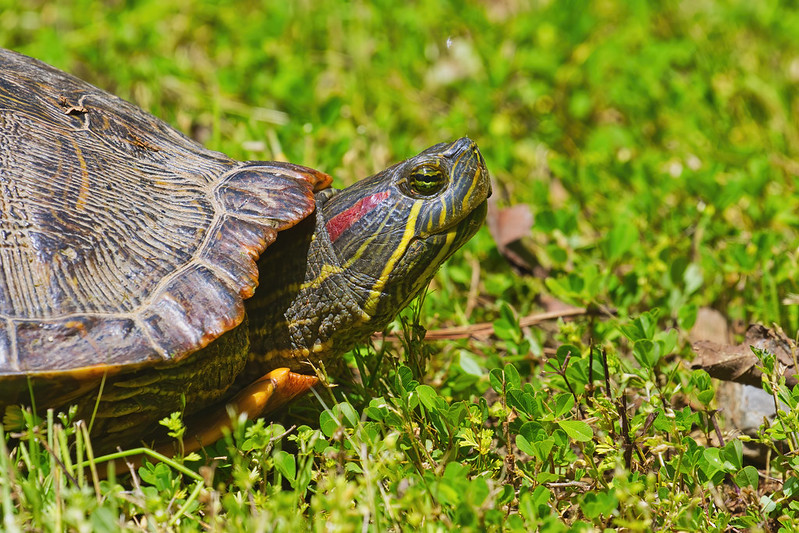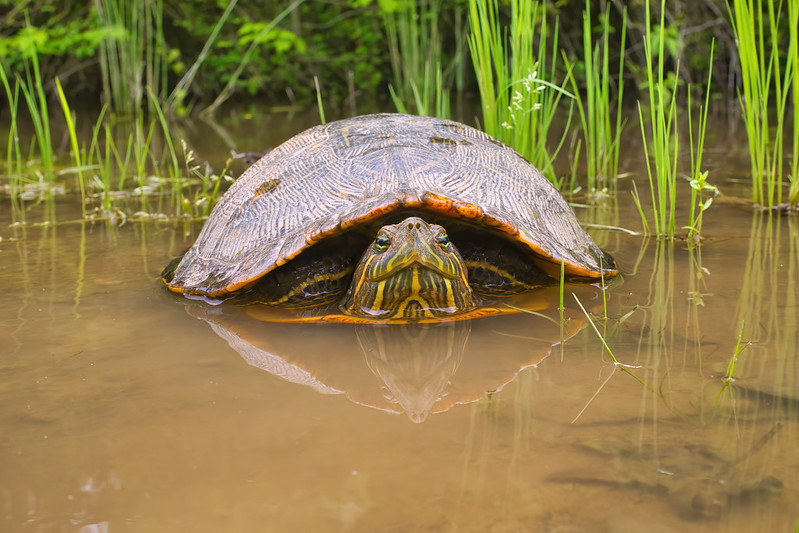Red-eared Sliders are captivating aquatic turtles, easily identified by the bright red markings just behind their eyes and their strong affinity for freshwater habitats. These turtles are commonly found in Arkansas and often leave the water to explore new environments or lay eggs. I had the opportunity to witness such a journey in April 2017, right in my own yard in the Ouachita Mountains of Arkansas.

Red-Eared Slider Sighting in My Arkansas Yard
One spring morning, I noticed a Red-eared Slider making its way across my yard, heading away from a nearby pond. Armed with my Canon EOS 7D Mark II and Canon EF 100-400mm f/4.5-5.6L IS II lens, I took a few photos as the turtle steadily moved through the grass. It was clearly on a purposeful trek, likely in search of a nesting site or a new aquatic home.
Trapped Turtle: A Red-Eared Slider Needs Help
To my surprise, I discovered the same turtle the following morning inside my fenced-in garden. It had managed to enter through an open gate but now found itself trapped, pacing the perimeter in search of an exit. After watching its movements for a while, I gently picked it up and relocated it to a nearby pool of water in the direction it had originally been heading. Using my Fujifilm X100T, I captured a few final shots as the turtle slid into deeper water and vanished.

Why Red-Eared Sliders Leave Water Habitats
Red-eared Sliders often leave their aquatic environments during the spring and summer months. Common reasons include overcrowding, deteriorating water quality, or the search for nesting areas. In Arkansas, females typically lay eggs between April and August, favoring sandy or loose soil near water. The eggs usually hatch within two to three months, with hatchlings making their way to the water to begin their aquatic lives.
These turtles are known for their remarkable adaptability, allowing them to survive in a variety of freshwater and terrestrial habitats. However, it’s important to remember that Red-eared Sliders are not native to Arkansas and are classified as an invasive species in many areas.
Observing Red-Eared Slider Behavior on Land
Encountering a Red-eared Slider on land offers a rare glimpse into the behavior and resilience of these turtles. Whether they’re in search of a nesting site or a better habitat, each journey tells a story of survival. If you come across one on your path, take a moment to admire its determination—and who knows, you might capture a lasting memory of a turtle on a mission.
Camera Settings For First Photo
- Aperture: f10
- ISO: 500
- Shutter speed: 1/800 sec.
- Focal Length: 400 mm
Camera Settings For Second Photo
- Aperture: f11
- ISO: 640
- Shutter speed: 1/125 sec.
- Focal Length: 23 mm (Fixed)
